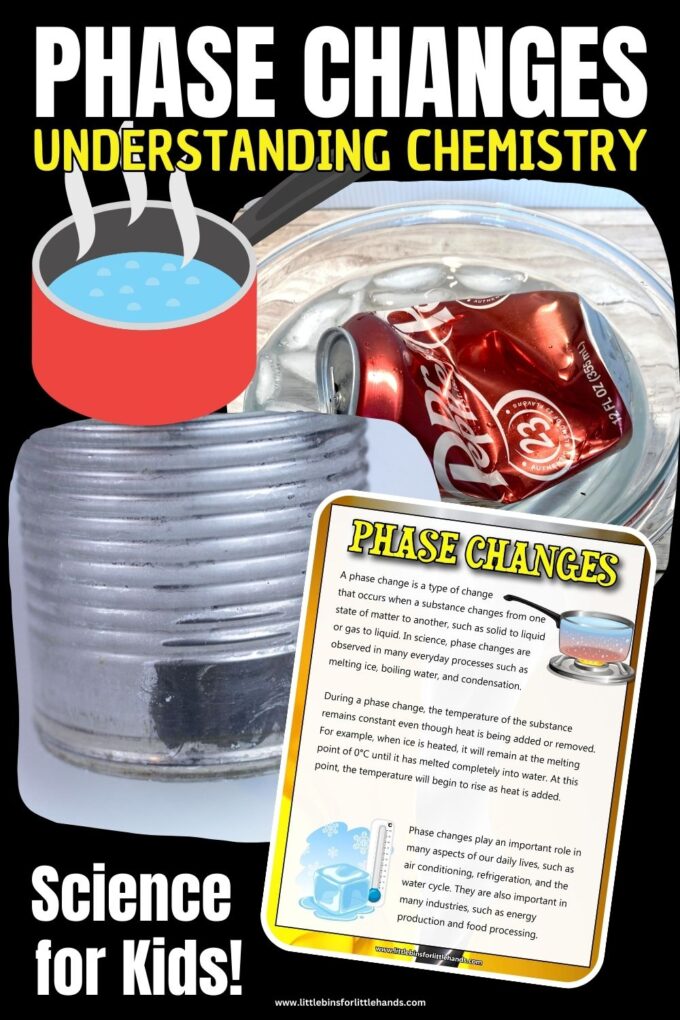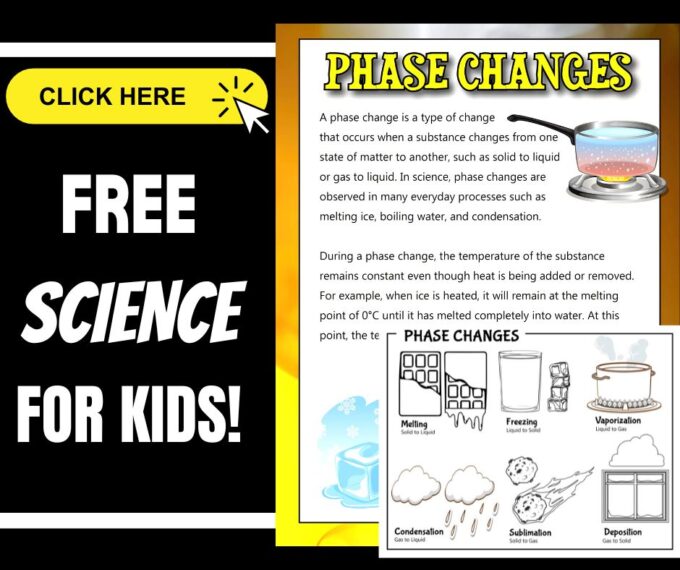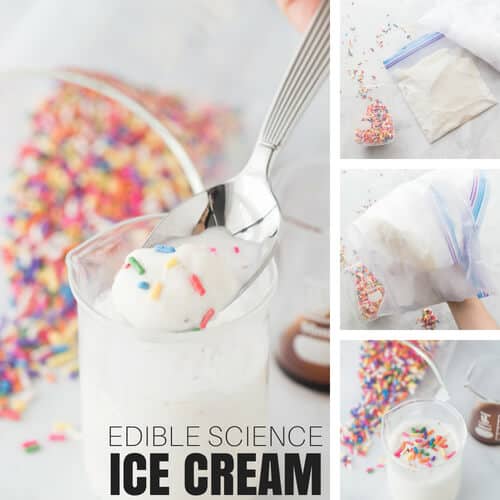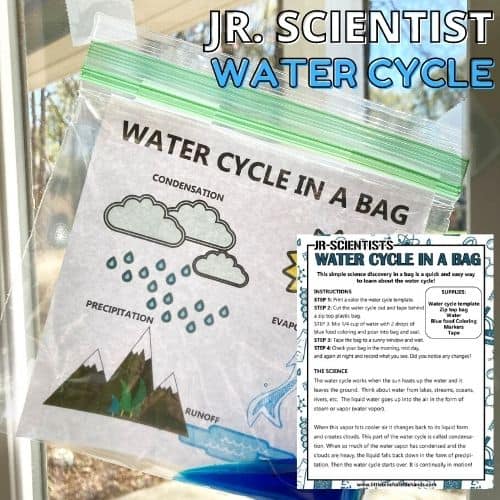What is a phase change? Learn about changing states of matter with a simple definition of phase change and everyday examples. Explore phase changes in science with easy, hands-on experiments kids will love and more. Fun science projects for kids of all ages!

Phase Change Chemistry
Let’s keep it simple for our junior scientists! Chemistry is all about how different materials are put together and what they are made up of, like atoms and molecules. Like all branches of science, chemistry is about solving problems and figuring out why things do what they do. Kids are great for questioning everything!
Our chemistry experiments will teach you about chemical reactions, acids and bases, solutions, crystals, and more! All with easy household supplies!
Encourage your kids to make predictions, discuss observations, and re-test their ideas if they don’t get the desired results the first time. Science always includes an element of mystery that kids naturally love to figure out! Learn more about the scientific method for kids.
Learn about what it means for a substance to undergo a phase change with one of these hands-on experiments below and our simple phase change definition and examples for kids.
What Is A Phase Change?
A phase change is a physical process that occurs when a substance changes from one state
of matter to another, such as solid to liquid or gas to liquid. Energy is needed to change phases of matter.
A phase change is not a chemical change, because the chemical composition of the substance remains the same even though its appearance has changed. Instead phase changes are a type of physical change.
Find more examples of physical change and chemical change!
Why Does A Phase Change Occur?
Phase changes occur because there is a change in the energy of a system. Some phase changes require the addition of energy by heat, and some require the removal of energy by heat.
For example; changing a liquid, where the molecules are close together, to a gas, where the molecules are farther apart, requires energy in the form of heat. This enables the molecules to break apart from each other.
The stronger the forces, the more energy is needed to overcome them. A solid will require more energy than a gas because it has stronger intermolecular bonds.
Learn more about the characteristics of solids, liquids and gasses.
Phase changes from solid to liquid, liquid to gas or solid to gas, require energy and are endothermic.
Phase changes from gas to liquid, liquid to solid and gas to solid, release energy and are exothermic.
Types Of Phases
There are 6 types of phase changes. The 4 common phase changes you would be familiar with, are melting, freezing, boiling, and condensation.
- The phase change from solid to liquid is called melting.
- The phase change from liquid to gas is called boiling.
- The phase change from gas to liquid is called condensation.
- The phase change from liquid to solid is called freezing.
Sublimation and Deposition Phase Change
Two other types of phase changes are called sublimation and deposition. In these phase changes, the substance transfers from solid to gas or gas to solid without passing through the liquid phase.
- Solid to gas is called sublimation.
- Gas to solid is called deposition or de-sublimation.
Sublimation can happen with snow. If the air is very dry, the snow turns into water vapor without becoming a liquid in the process. Sublimation is an exothermic process.
An example of deposition is when water vapor in the atmosphere changes directly into ice, such as when frost is formed. Deposition is an endothermic process.
Phase Changes of Water
Phases changes of water include:
- solid to liquid – melting ice
- liquid to gas – boiling or evaporating water
- gas to liquid – condensation of water vapor
- liquid to solid – freezing water
Does one phase take more energy than another? The change to gas takes up the most energy because in order to do so the bonds between the particles have to completely separate.
The bonds in a solid only have to loosen up a bit to change phase such as a solid ice cube changing to liquid water.
During a phase change, the temperature of the substance remains constant even though heat is being added or removed.
For example, when ice is heated, it will remain at the melting point of 0°C until it has melted completely into water. At this point, the temperature of the water will begin to rise as heat is added.
10 Examples Of Phase Changes
Phase changes play an important role in many aspects of our daily lives, and in industry. Here are a few ideas, can you think of any more?
- making ice cream
- making chocolate
- making LEGO crayons
- dehydrating food
- burning liquid fuel in a camping stove
- air conditioning
- coolant in refrigeration
- hot and cold water storage systems
- melting gold
- water cycle
FREE Phase Change Info pack to get started!
Share examples of phase changes and the fun science behind them with this free printable phase changes guide.
Phase Change Experiments
Here are some fun examples of phase change experiments that use everyday household items. What could be easier!
Want to introduce the concept of phase change to younger kiddos? Check out our ice play activities for tons of fun ideas for ice melting sensory play!
Crushing Soda Can
Who would have thought the condensation of water (gas to liquid) could crush a soda can!
Freezing Bubbles
This is a fun phase change experiment to try in the winter. Can you turn liquid bubble mixture into a solid?
Freezing Water Experiment
Explore the freezing point of water and discover what happens when you freeze salt water. All you need are some bowls of water and salt.
Frost On A Can
A fun winter experiment for anytime of the year. Turn water vapor into ice when it touches the surface of your cold metal can.
Ice Cream In A Bag
Make a yummy frozen treat using ice and salt. Turn liquid milk and cream into a solid you can eat!
Ice Melting Experiment
What makes ice melt faster? Try three fun and easy to set up ice science experiments.
Ivory Soap
What happens to ivory soap when you heat it? It’s all because water changes from a liquid to a gas.
Making Soap
The process of making soap from a simple glycerin base involves several phase changes. Even better you end up with a fun surprise at the end!
Melting Chocolate
A super simple science activity that you get to eat!
Melting Crayons
Recycle your old crayons into new crayons with our easy instructions. Plus, melting crayons is also a great example of a reversible phase change from solid to liquid to solid.
Solid Liquid Gases
Observe the phase changes in water from solid to liquid to gas in a fun and easy way. Perfect for young kids, as well as older kids too!
Snow Candy
This is a fun activity to do in the winter, when you have snow! Turn liquid maple syrup into an edible snow candy. Don’t have snow, you can use the freezer!
Water Cycle In A Bag
Not only is the water cycle important for all life on earth, it is also a great example of phase changes of water, including evaporation and condensation.
Science Experiments By Age Group
We’ve put together a few separate resources for different age groups, but remember that many experiments will cross over and can be re-tried at several different age levels. Younger kiddos can enjoy the simplicity and hands-on fun. At the same time, you can talk back and forth about what is happening.
As kiddos get older, they can bring more complexity to the experiments, including using the scientific method, developing hypotheses, exploring variables, creating different tests, and writing conclusions from analyzing data.
- Science for Toddlers
- Science for Preschoolers
- Science for Kindergarten
- Science for Early Elementary Grades
- Science for 3rd Grade
- Science for Middle School
More Helpful Science Resources
Science Terms
It is never too early to introduce some fantastic science words to kids. Get them started with a printable science vocabulary word list. You’re definitely going to want to incorporate these simple science terms into your next science lesson!
What Is A Scientist
Think like a scientist! Act like a scientist! Scientists like you and me are also curious about the world around them. Learn about the different types of scientists and what they do to increase their understanding of their areas of interest. Read What Is A Scientist
Science Books For Kids
Sometimes the best way to introduce science concepts is through a colorfully illustrated book with characters your kids can relate to! Check out this fantastic list of science books that are teacher approved and get ready to spark curiosity and exploration!
Science and Engineering Practices
A new approach to teaching science is called the Best Science Practices. These eight science and engineering practices are less structured and allow for a more free–flowing approach to problem-solving and finding answers to questions. These skills are critical to developing future engineers, inventors, and scientists!
DIY Science Kit
You can easily stock up on the main supplies for dozens of fantastic science experiments to explore chemistry, physics, biology, and earth science with kids in preschool through middle school. See how to make a DIY science kit here and grab the free supplies checklist.
Science Tools
What tools do most scientists commonly use? Grab this free printable science supplies list to add to your science lab, classroom, or learning space!
Printable Science Projects For Kids
If you’re looking to grab all of our printable science projects in one convenient place plus exclusive worksheets and bonuses like a STEAM Project pack, our Science Project Pack is what you need! Over 300+ Pages!
- 90+ classic science activities with journal pages, supply lists, set up and process, and science information. NEW! Activity-specific observation pages!
- Best science practices posters and our original science method process folders for extra alternatives!
- Be a Collector activities pack introduces kids to the world of making collections through the eyes of a scientist. What will they collect first?
- Know the Words Science vocabulary pack includes flashcards, crosswords, and word searches that illuminate keywords in the experiments!
- My science journal writing prompts explore what it means to be a scientist!!
- Bonus STEAM Project Pack: Art meets science with doable projects!
- Bonus Quick Grab Packs for Biology, Earth Science, Chemistry, and Physics











